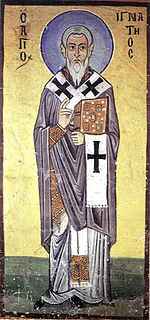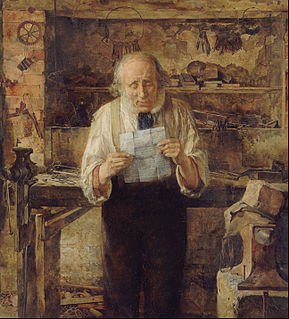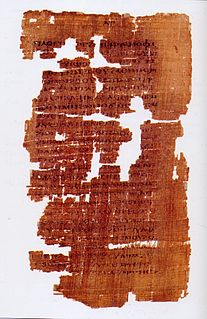Hangman is a paper and pencil guessing game for two or more players. One player thinks of a word, phrase or sentence and the other(s) tries to guess it by suggesting letters within a certain number of guesses.

Ignatius of Antioch, also known as Ignatius Theophorus, was an early Christian writer and Patriarch of Antioch. While en route to Rome, where he met his martyrdom, Ignatius wrote a series of letters. This correspondence now forms a central part of a later collection of works known to be authored by the Apostolic Fathers. He is considered to be one of the three most important of these, together with Clement of Rome and Polycarp. His letters also serve as an example of early Christian theology. Important topics they address include ecclesiology, the sacraments, and the role of bishops.

A letter is a written message conveyed from one person to another through a medium. The term usually excludes written material intended to be read in its original form by large numbers of people, such as newspapers and placards, although even these may include material in the form of an "open letter". The typical form of a letter for many centuries, and the archetypal concept even today, is a sheet of paper that is sent to a correspondent through a postal system. A letter can be formal or informal, depending on its audience and purpose. Besides being a means of communication and a store of information, letter writing has played a role in the reproduction of writing as an art throughout history. Letters have been sent since antiquity and are mentioned in the Iliad. Historians Herodotus and Thucydides mention and use letters in their writings.

Pope Clement I, also known as Saint Clement of Rome, is listed by Irenaeus and Tertullian as the fourth bishop of Rome, holding office from 88 AD to his death in 99 AD. He is considered to be the first Apostolic Father of the Church, one of the three chief ones together with Polycarp and Ignatius of Antioch.

Henricus Antonius "Han" van Meegeren was a Dutch painter and portraitist, considered one of the most ingenious art forgers of the 20th century. Van Meegeren became a national hero after World War II when it was revealed that he had sold a forged painting to Reichsmarschall Hermann Göring during the Nazi occupation of the Netherlands.
The comma, is a punctuation mark that appears in several variants in different languages. It has the same shape as an apostrophe or single closing quotation mark in many typefaces, but it differs from them in being placed on the baseline of the text. Some typefaces render it as a small line, slightly curved or straight but inclined from the vertical. Other fonts give it the appearance of a miniature filled-in figure 9 on the baseline.

Aubrey Vincent Beardsley was an English illustrator and author. His black ink drawings were influenced by Japanese woodcuts, and depicted the grotesque, the decadent, and the erotic. He was a leading figure in the aesthetic movement which also included Oscar Wilde and James McNeill Whistler. Beardsley's contribution to the development of the Art Nouveau and poster styles was significant despite his early death from tuberculosis. He is one of the important Modern Style figures.

Postage stamps and postal history of Great Britain surveys postal history from the United Kingdom and the postage stamps issued by that country and its various historical territories until the present day.
The salamander letter was a controversial document about the history of the Latter Day Saint movement that later proved to be a forgery.
Mark William Hofmann is an American counterfeiter, forger, and convicted murderer. Widely regarded as one of the most accomplished forgers in history, Hofmann is especially noted for his creation of documents related to the history of the Latter Day Saint movement. When his schemes began to unravel, he constructed bombs to murder three people in Salt Lake City, Utah. The first two bombs killed two people on October 15, 1985. On the following day, a third bomb exploded in Hofmann's car. He was arrested for the bombings three months later, and in 1987 pleaded guilty to two counts of second-degree murder, one count of theft by deception and one count of fraud.

Pseudepigrapha are falsely attributed works, texts whose claimed author is not the true author, or a work whose real author attributed it to a figure of the past.

The Secret Gospel of Mark or the Mystic Gospel of Mark, also the Longer Gospel of Mark, is a putative longer and secret or mystic version of the Gospel of Mark. The gospel is mentioned exclusively in the Mar Saba letter, a document of disputed authenticity, which is said to be written by Clement of Alexandria. This letter, in turn, is preserved only in photographs of a Greek handwritten copy seemingly transcribed in the eighteenth century into the endpapers of a seventeenth-century printed edition of the works of Ignatius of Antioch.
The Greek alphabet has been used to write the Greek language since the late ninth or early eighth century BC. It is derived from the earlier Phoenician alphabet, and was the earliest known alphabetic script to have distinct letters for vowels as well as consonants. In Archaic and early Classical times, the Greek alphabet existed in many local variants, but, by the end of the fourth century BC, the Euclidean alphabet, with twenty-four letters, ordered from alpha to omega, had become standard and it is this version that is still used for Greek writing today.

The Potato Eaters is an oil painting by Dutch artist Vincent van Gogh painted in April 1885 in Nuenen, Netherlands. It is in the Van Gogh Museum in Amsterdam. The original oil sketch of the painting is at the Kröller-Müller Museum in Otterlo, and he also made lithographs of the image, which are held in collections including the Museum of Modern Art in New York City. The painting is considered to be one of Van Gogh's masterpieces.

Sorrowing Old Man is an oil painting by Vincent van Gogh that he made in 1890 in Saint-Rémy de Provence based on an early lithograph. The painting was completed in early May at a time when he was convalescing from a severe relapse in his health some two months before his death, which is generally accepted as a suicide.

James Wilmot was an English clergyman and scholar from Warwickshire. During his lifetime, he was apparently unknown beyond his immediate circle.

In general, philatelic fakes and forgeries are labels that look like postage stamps but have been produced to deceive or defraud. Learning to identify these can be a challenging branch of philately.
The Epistles of Plato are a series of thirteen letters traditionally included in the Platonic corpus. Their authenticity has been the subject of some dispute, and scholarly consensus has shifted back and forth over time. They were "generally accepted as genuine until modern times"; but by the close of the nineteenth century, many philologists believed that none of the letters were actually written by Plato. Now every letter except the First has some defenders of its authenticity. The Twelfth is also widely regarded as a forgery, and the Fifth and Ninth have fewer supporters than the others.

William Shakespeare's handwriting is known from six surviving signatures, all of which appear on legal documents. It is believed by many scholars that the three pages of the handwritten manuscript of the play Sir Thomas More are also in William Shakespeare's handwriting. This is based on many studies by a number of scholars that considered handwriting, spelling, vocabulary, literary aspects, and more.
Leonore Carol "Lee" Israel was an American author known for committing literary forgery. Her 2008 confessional autobiography Can You Ever Forgive Me? was adapted into the 2018 film of the same name starring Melissa McCarthy as Israel.













